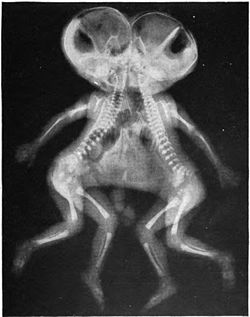Conjoined twins

Editor-In-Chief: Prab R Tumpati, MD
Obesity, Sleep & Internal medicine
Founder, WikiMD Wellnesspedia &
W8MD's medical weight loss NYC, sleep center NYC
Philadelphia medical weight loss and Philadelphia sleep clinics
| Conjoined twins | |
|---|---|

| |
| Synonyms | Siamese twins |
| Pronounce | N/A |
| Specialty | N/A |
| Symptoms | Physical connection of two bodies |
| Complications | Organ sharing, surgical separation |
| Onset | Congenital |
| Duration | Lifelong |
| Types | N/A |
| Causes | Monozygotic twinning |
| Risks | Premature birth, Stillbirth |
| Diagnosis | Ultrasound, MRI |
| Differential diagnosis | Parasitic twin, Teratoma |
| Prevention | N/A |
| Treatment | Surgical separation |
| Medication | N/A |
| Prognosis | Varies depending on type of conjoining and organ sharing |
| Frequency | 1 in 49,000 to 1 in 189,000 births |
| Deaths | N/A |
A monoamniotic twin gestation in which the twins share one or more organs.


Conjoined twins are also known as siamese twins, and are a rare phenomenon in which two individuals are born physically connected to each other. This condition results from a monoamniotic twin gestation, where the twins share the same amniotic sac during development and can share one or more organs.
Development and Causes[edit]
Monoamniotic twins develop from a single fertilized egg, or zygote, that fails to separate completely after around 8 to 12 days following fertilization. If the separation occurs later than this, the twins can become conjoined. The exact cause of the incomplete separation is unknown.
Types of Conjoined Twins[edit]
There are several types of conjoined twins, categorized based on the point of attachment:
- Thoracopagus: Attached at the upper portion of the torso, sharing a heart.
- Omphalopagus: Attached at the lower chest and upper abdomen, may share liver but usually have separate hearts.
- Pygopagus: Attached back to back at the buttocks, may share a lower gastrointestinal tract.
- Craniopagus: Attached at the head, the rarest type.
Diagnosis[edit]
Prenatal ultrasound is the primary method for diagnosing conjoined twins during pregnancy. More detailed imaging, like MRI or CT scan, may be used to understand the extent of organ sharing and plan for possible separation surgery.
Treatment and Prognosis[edit]
Treatment for conjoined twins varies greatly depending on the degree of organ sharing and overall health of the twins. If feasible, surgical separation may be considered, but carries significant risks. The prognosis for conjoined twins varies widely, with survival rates higher for those who share fewer organs.
See Also[edit]
Ad. Transform your life with W8MD's Budget GLP-1 injections from $75


W8MD offers a medical weight loss program to lose weight in Philadelphia. Our physician-supervised medical weight loss provides:
- Weight loss injections in NYC (generic and brand names):
- Zepbound / Mounjaro, Wegovy / Ozempic, Saxenda
- Most insurances accepted or discounted self-pay rates. We will obtain insurance prior authorizations if needed.
- Generic GLP1 weight loss injections from $75 for the starting dose.
- Also offer prescription weight loss medications including Phentermine, Qsymia, Diethylpropion, Contrave etc.
NYC weight loss doctor appointmentsNYC weight loss doctor appointments
Start your NYC weight loss journey today at our NYC medical weight loss and Philadelphia medical weight loss clinics.
- Call 718-946-5500 to lose weight in NYC or for medical weight loss in Philadelphia 215-676-2334.
- Tags:NYC medical weight loss, Philadelphia lose weight Zepbound NYC, Budget GLP1 weight loss injections, Wegovy Philadelphia, Wegovy NYC, Philadelphia medical weight loss, Brookly weight loss and Wegovy NYC
|
WikiMD's Wellness Encyclopedia |
| Let Food Be Thy Medicine Medicine Thy Food - Hippocrates |
Medical Disclaimer: WikiMD is not a substitute for professional medical advice. The information on WikiMD is provided as an information resource only, may be incorrect, outdated or misleading, and is not to be used or relied on for any diagnostic or treatment purposes. Please consult your health care provider before making any healthcare decisions or for guidance about a specific medical condition. WikiMD expressly disclaims responsibility, and shall have no liability, for any damages, loss, injury, or liability whatsoever suffered as a result of your reliance on the information contained in this site. By visiting this site you agree to the foregoing terms and conditions, which may from time to time be changed or supplemented by WikiMD. If you do not agree to the foregoing terms and conditions, you should not enter or use this site. See full disclaimer.
Credits:Most images are courtesy of Wikimedia commons, and templates, categories Wikipedia, licensed under CC BY SA or similar.
Translate this page: - East Asian
中文,
日本,
한국어,
South Asian
हिन्दी,
தமிழ்,
తెలుగు,
Urdu,
ಕನ್ನಡ,
Southeast Asian
Indonesian,
Vietnamese,
Thai,
မြန်မာဘာသာ,
বাংলা
European
español,
Deutsch,
français,
Greek,
português do Brasil,
polski,
română,
русский,
Nederlands,
norsk,
svenska,
suomi,
Italian
Middle Eastern & African
عربى,
Turkish,
Persian,
Hebrew,
Afrikaans,
isiZulu,
Kiswahili,
Other
Bulgarian,
Hungarian,
Czech,
Swedish,
മലയാളം,
मराठी,
ਪੰਜਾਬੀ,
ગુજરાતી,
Portuguese,
Ukrainian


